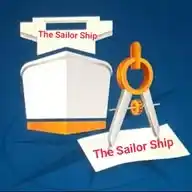
Chief Mate Oral Set The Sailor Ship
February 18, 2025 at 11:17 AM
[17/02, 18:52] +91 97694 64921: Mumbai MMD
Date-17.02.204
Internal-Gp Shenoy
External - Martin
Fun-3
—---------------------
1. What is virtual Loss of Gm in dry dock - i said upthrust created by block called P and explained. He said wrong
2. How will you berthing the ship without tug - explained dredging of anchor ( not satisfied)
3. Wind heeling criteria- I explained imo wind heeling criteria Iw1 steady wind heeling lever Iw2 gusty wind heeling lever and explained the formulas - he said wrong
4. Condition for open moor and running moor - explained but he said wrong
5. Scopic clause - he was not satisfied
6. Collision both to blame clause- not satisfied
7. Principal of ground tackle to refloat- didn't know
8. Solas chapter 1 certificates
9. Solas chapter11-1 contents
10. Solas chapter -12 contents
11. How psc conduct psc inspection - i said vsl categories risk profile like highrisk, standard risk, low risk followed by p1,p2p3 category - he said wrong
12. What is suspension of inspection under PSC- don't know the answer
13. Marpol discharge criteria for cargo wash water - i start answering as per categories in HME AND non HME cargo.
14. Where will u get details of Hme and non HME. I said shipper declaration.which section of shipper declaration
15. What is the requirement for HME and Non hme cargoes under IMSBC Code - don't know
16. Bunker clc applicable in india - Ans is not applicable
17. Survey required as per which chapter of solas and what is difference between each survey.
I don't know what he is expecting. Whatever I was telling he said wrong
Result- Fail
[17/02, 19:07] +91 76964 69177: Capt martin
Dg loading, lodicator stopped action ?
Dg leakage and casualty, action ?
What is D mac in CSC ?
How will you know the container is tested or not ?
Alternative lashing of timber cargo ?
This was asked by him December me when i gave orals
[17/02, 20:05] +91 98677 45799: Q. How can a ship with bow damage be drydocked?
Ans. The ‘straight forward dry-docking’ itself, is a critical operation. A ship with the bow damage is definitely more complex than normal dry-docking. Definitely, an expert’s guidance would be needed. The location, size and type of damage are very crucial in deciding how complex the dry-docking would be.
The different types of situations can be due to the following:
1. Damage to an empty compartment.
2. Damage involving general cargo and hold accessible from inside.
3. Damage involving bulk cargo and hold not accessible from inside.
4. Damage symmetrical about centre line.
5. Damage not symmetrical causing list.
6. Damage above or below the water line.
7. Damage to hull being well defined, allowing a temporary patch-up to prevent free flow of water.
8. Damage irregular, where the hull plates do not allow temporary patch-up.
9. Damage causing excessive trim.
10. Damage to the side of a compartment versus damage to the bottom.
The prime focus should be to maintain the intactness of the hull by providing a temporary patch by welding a thin sheet around the damage or covering the damage by a repair kit that may be available or a cement box and then pumping out water from the compartment so that there is no free flow of water or adding of water mass.
[17/02, 23:09] +44 7948 538896: Yes if all certificates are issued by Flag / Administration. Class only does survey and certification on behalf of Flag. Big debate but class is not essential from flag perspective if flag's knowhow and surveyor database is large enough to accommodate survey and attendance in Vessel's trading area.
But if Class is revoked due to some incident or non maintenance of equipment or due to non-completion of statutory surveys within the specified window, then the Vessel cannot sail without the class.
The first example above, allowed to sail, is for a fully compliant ship without Class who can sail, whereas the second example above is a non-compliant ship without Class who cannot sail.
[18/02, 14:32] +91 86551 65291: Lifeboat testing requirements are governed by SOLAS (Safety of Life at Sea) and IMO (International Maritime Organization) regulations. Here’s a summary:
1. Weekly Tests (SOLAS III/19.3.4.3)
• Start and run the lifeboat engine for at least 3 minutes.
• Check the lifeboat’s equipment, engine, steering, and communication systems.
2. Monthly Tests (SOLAS III/19.3.4.6)
• Lower each lifeboat to the water (if practical) or to the embarkation deck.
• Inspect the davits, winches, and release mechanisms.
• Run the lifeboat engine ahead and astern in water, if conditions permit.
3. Quarterly Tests (SOLAS III/20.6.3) (for free-fall lifeboats)
• Conduct a free-fall launch or simulated launch using a test load or crew under supervision.
4. Annual Tests (SOLAS III/20.11.2) (Class-approved service provider required)
• Full inspection and operational test of the lifeboat, release gear, engine, and davit system.
• Launch each lifeboat to the water and carry out a full functional test.
• Check lifeboat equipment, including emergency rations, communication devices, and fire extinguishers.
5. 5-Yearly Tests (MSC.402(96))
• Dynamic test of release gear with a test load equal to 1.1 times the lifeboat’s weight.
• Overhaul and load testing of davits and winches.
• Check the hydrostatic release unit (HRU) and lifeboat structure for any cracks or
[18/02, 15:19] +91 97803 05195: 17.02.2025
Int: capt. manish kumar
Ext: capt. devesh sinha
Funcn 3
loadicator requirements
hongkong convention
existing ships conversion to hong kong convention
who issues certificate for hong kong convention
class and ro
fsi and psi
psc number of memorandums
ranging of anchor
what all is checked
few more questions don't remember
Internal no questions
Finally mate
thanku everyone for your assistance